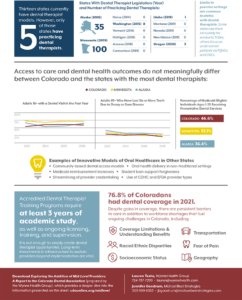 Prior to the 2020 legislative session, the CDA made a commitment to Sen. Dominick Moreno to bring on an external independent consulting group that would convene Colorado stakeholders, gather information, and determine where Colorado had specific oral health needs or gaps in care. In addition to assessing need in Colorado, the group was asked to evaluate current dental care programs, scope of practice allowances, oral health innovations and provider types. The CDA applied for and received grant funding from the American Dental Association to hire a consulting group to create a report with impartial information about Colorado’s oral health gaps in care, current workforce and the need for a mid-level provider type in Colorado. The CDA hired the Wynne Health Group, a highly respected national health policy firm dedicated to expanding access-to-care and improving health.
Prior to the 2020 legislative session, the CDA made a commitment to Sen. Dominick Moreno to bring on an external independent consulting group that would convene Colorado stakeholders, gather information, and determine where Colorado had specific oral health needs or gaps in care. In addition to assessing need in Colorado, the group was asked to evaluate current dental care programs, scope of practice allowances, oral health innovations and provider types. The CDA applied for and received grant funding from the American Dental Association to hire a consulting group to create a report with impartial information about Colorado’s oral health gaps in care, current workforce and the need for a mid-level provider type in Colorado. The CDA hired the Wynne Health Group, a highly respected national health policy firm dedicated to expanding access-to-care and improving health.
Summary of Key Findings
Wynne Health Group Report: Exploring the Addition of Mid-Level Dental Providers in Colorado
Top Takeaways:
- Colorado stakeholders are largely unconvinced that the addition of dental therapists (DTs) would be the best solution to address the oral health gaps they see in Colorado.
- Colorado has a strong history of innovative approaches to improving oral healthcare, as well as efforts that have not yet fully realized their potential to positively impact oral health.
- Expanding investments in existing initiatives and addressing current barriers could maximize positive impacts of these innovations. Recommended investments included those targeted at prevention and patient education, delivery system reform, workforce diversity and shortages, and payment reform.
- Decisions on introduction of DTs should follow the development of a strategic oral health vision for Colorado. Decisions about public investments in oral health should be made based on evidence regarding how each is proven to achieve Colorado’s vision.
- Several federal and state reports and plans will be released soon and should be considered in the creation of any oral health plan and any DT legislation for Colorado.
- Given limited resources, Colorado should prioritize investments with the greatest impact, shaped by the voices and desires of communities the investments are intended to serve.
- Colorado must ask, given the long time needed to successfully integrate a DT model, what the state may not be able to fund over the next decade by focusing on a DT approach.
Colorado’s Oral Health Status and Innovations: Includes data on Colorado’s oral health status, COVID impacts, state and federal policy interventions, and Colorado innovations such as adult Medicaid dental, senior dental coverage, expansions to dental hygiene scope of practice, telehealth-connected virtual dental homes (SMILES), Cavity Free at 3 prevention, school-based dental, medical-dental integration, and charitable care.
- Colorado’s oral health status, including dental insurance coverage and dental care utilization, have notably increased in recent years.
- Still disparities in oral health access and outcomes as well as workforce shortages persist. Disparities often correlate with age (children), geography (rural), socioeconomic status (lower income) and racial/ethnic identity (Hispanic, black, other).
Innovative Models in Other States: Reviews other innovations including community-based dental access models, oral health delivery in non-traditional settings, Medicaid reimbursement ideas and streamlining of credentialing, student loan support, use of CDHC and EFDA provider types, and oral health literacy programs.
- Implementing multiple complementary strategies results in the greatest improvements.
Summary of Other State Dental Therapist (DT) Models: Examines varying state models.
- Populations Served: Limits to practice settings are common. Some states use DTs exclusively for service to tribes, others serve underserved patients via Federally Qualified Health Centers and Community Health Centers.
- Education and Licensing Standards: Most states use CODA educational requirements, requiring at least three years of academic study (no specific degree requirement).
- About half of states require dual licensing, meaning DTs must be educated and licensed for both dental hygiene and DT roles.
- Some states have preceptorship and other training requirements.
- Supervision and Scope of Practice: Scope typically includes diagnostic, preventive and some restorative services. Specific services vary by state. Practice agreements with dentists are generally required for DTs to practice with supervision level varying by state. See pages 25-27 in the full report.
- Cost Efficacy, Payment Models and ROI: A (Pew) report found DT employment profitable, but a 2012 analysis found DTs would not meaningfully lower the cost of care.
- Uptake and Efficacy in Other States: There are no DTs in 8 (61.5%) of the 13 states that currently have DT models (enactment dates range from 2014 to 2019).
- States that introduced DTs after 2009 generally do not have enough data yet to reliably assess effectiveness. Scarcity of training programs and slots results in few actively practicing DTs, with license portability posing another barrier.
- Models appear to work as intended when DTs are available and deployed as part of a comprehensive set of dental access policies.
- Past Colorado interventions may be close to or as effective as DTs when comparing access statistics between Colorado and states with active DTs.
Colorado Stakeholder Assessment and Input: Highlights pros and cons of DTs for Colorado based on input from a broad group of local stakeholders.
- Affordability: Separate reimbursement for billing DT services may make care more affordable for the state and consumers. But separate reimbursement could directly conflict with and disrupt broader payment parity efforts in Colorado’s dental and medical landscape.
- Rural Distribution Gaps: Providers generally choose well-resourced communities due to a myriad of factors, so purposeful action should be taken to focus a DT model on areas and populations with greatest needs. Multiple approaches are possible: geographic incentives, geographic requirements, or demographic requirements. There is no precedent for geographic or demographic restrictions on provider licenses in Colorado. This change may face resistance from the state’s administration and other stakeholders.
- Equity / Disproportionately Impacted Communities: Individuals from communities of need may become DTs and return to provide care with added benefits of increased diversity and cultural competency. Some stakeholders questioned the ethics of providing underserved communities with providers with less education and training (and potentially a lower standard or quality of care) than offered to well-resourced communities. Targeting communities in need to fill DT positions may inadvertently result in career limitations for these students and increase inequities, as job growth and earning can be limited potential by nature of being a mid-level provider. Restricting DTs to practice only in underserved communities could also limit jobs to areas that can be less profitable to work in.
- Dental Disease Cycle: Most dental issues can be prevented. Stakeholders worry that prevention is often overlooked until problems are magnified, and expensive invasive surgical procedures are needed. The DT model may invest in an approach that is no different.
- Overlap and Impact on Colorado’s Existing Dental Hygienist Role: Given Colorado’s expansive use of dental hygienists, DTs may heavily duplicate their role—impacting sustainability for Colorado’s dental hygiene workforce. Also, without addressing barriers faced by current dental providers, DTs may face many identical challenges with the additional burden of little to no license portability between states.
- Education Costs and Timeline for Impact: A new educational program and licensing path for DTs requires intensive time and resource investments, including financial support as universities design a program that aligns with Colorado’s needs. Many years may pass before the first DTs in Colorado begin to practice. The resources needed to support a successful DT model means many other oral health priorities could be postponed.
- Supervision and Scope of Practice: DTs must be prepared to practice alone in underserved areas as the only dental provider within a significant distance, able to handle dental emergencies and complications until the patient can get to a dentist. DTs must be prepared to handle complex patients, as many patients in underserved communities are medically complex in part due to limited access.
Key Policy Considerations: Highlights policy areas that should be addressed in any proposal.
- Colorado must first understand two key questions: (1) what is the problem that dental therapy should address; and (2) why does the problem exist?
- This information will influence if a DT model should be pursued, and what model would best serve these needs. Colorado should also consider if dental hygienists and dental assistants can fill the presumptive roles of a DT with the removal of practice barriers.
- It is not enough to simply create DT opportunities—investments in infrastructure to sustain providers beyond implementation are vital.
Recommendations to Improve Oral Health: Suggests key strategies, including:
- Create a Data-Driven, Stakeholder Informed Vision for Oral Health in Colorado: Via a legislative process or by a non-legislative entity, such as Colorado Health Institute or the Wynne Health Group.
- CDPHE will release its Oral Health Strategic Plan in early 2022. The NIH Surgeon General’s update to the Oral Health in America national report was released in December 2021. Both should be used to guide Colorado’s approach to DTs and oral health policy.
- Integrate Community Voice: Colorado has not heard enough from consumers about the care they need, where they would like to receive it, and how it should look. Two key questions require answers: What are Colorado’s needs from a patient perspective? What solutions do patients see as meeting their needs?
- Implement and Expand Innovative Delivery Models: Minimally invasive dental care may offer a greater positive impact across a larger population than investment in surgical care available to fewer patients. Opportunity remains to expand telehealth, integrated care and school-based care for populations and geographic areas that are not yet served.
- Invest in Prevention and Education: Prioritize optimal levels of fluoride, sealants, Cavity Free at 3, school-based programs, and public education campaigns.
- Increase Workforce Capacity and Diversity: Continue to expand the racial/ethnic and linguistic diversity of the dental workforce to address disparities in access and outcomes for historically underserved groups. Possible pathways include pipeline programs, educational subsidies, hybrid online education, practicums, mentorships, and loan forgiveness.
- Test Payment Reforms to drive the identified priority behaviors.
- Mid-Level Provider Considerations: While most stakeholders felt solutions other than DTs had greater potential for positive impact on oral health, mid-level providers should be considered as one of a range of potential approaches to improve oral health in Colorado. To pursue this model, benefits as they align with Colorado’s vision for oral health should outweigh benefits achieved if alternate investments are made.




